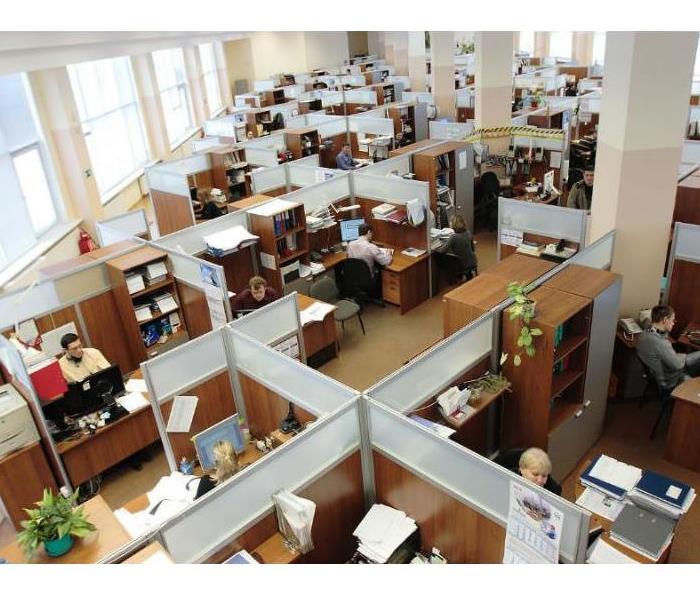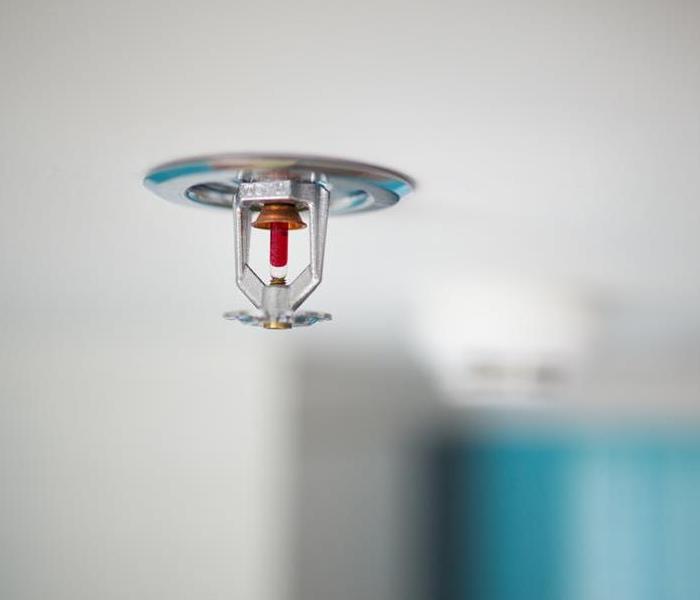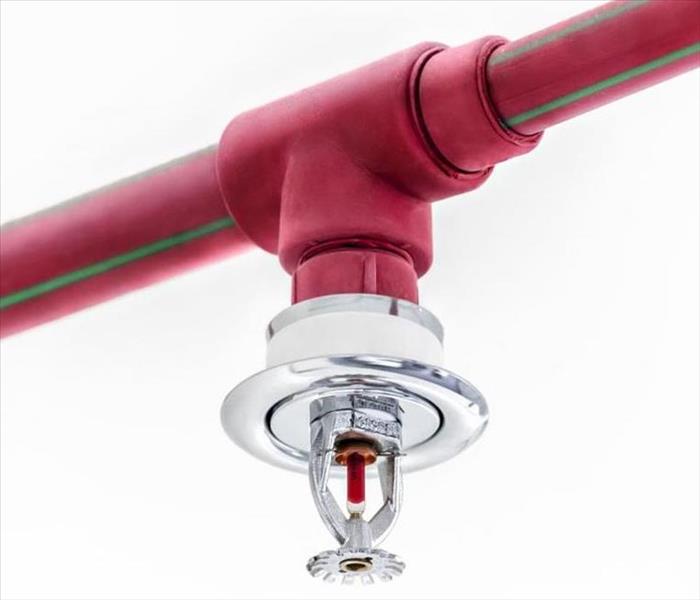Archived Commercial Blog Posts
Fire Damage and Water Damage
10/15/2022 (Permalink)
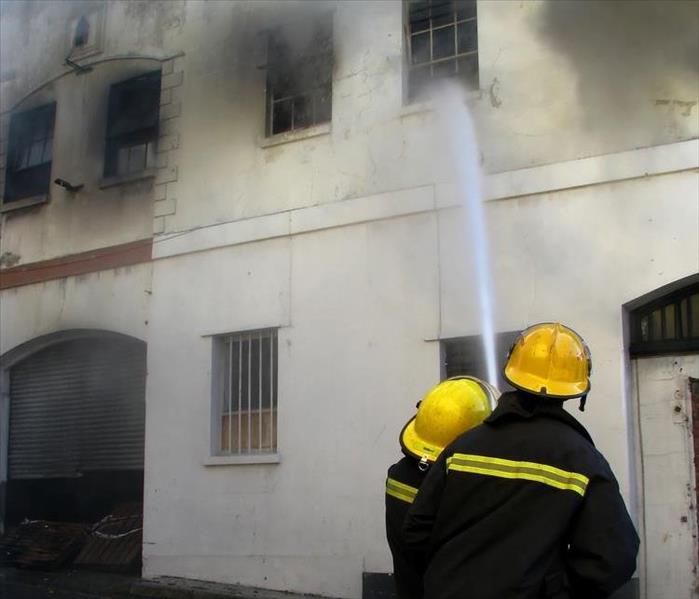 Commercial fire damage
Commercial fire damage
Fire Damage and Water Damage
Fire and water are the most common causes of damage in homes and businesses, so it’s important for you to know how they differ. Fire can cause severe damage to your structure or business, but water damage is a byproduct of fire. The more water used, the more water damage there will be to your structure. Water damage comes from sprinklers as well as fire hoses used by first responders. As an example: In a typical residential fire (where only one room is on fire), firefighters use about 5 gallons of water per minute while fighting the blaze; however, if they have to fight off flames in two separate rooms at once—or if they must ventilate the area after putting out a blaze—then they might need 10 times that amount of water per minute!
Fire damage is not just damage from burning.
Fire can cause smoke, heat, and water damage. Smoke can cause damage to the structure and contents of the building. Heat from fire can destroy walls and other structural components of your home. Water used to extinguish a fire often damages ceilings, floors, walls and other components of your home or business.
Water damage is a byproduct of fire damage.
The water used to put out the flames will make its way into your home, causing severe damage to any property it touches.
The more water used, the more water damage to the structure.
When a fire breaks out in your home or business, you need to call 911 immediately and evacuate everyone from the premises until firefighters arrive on scene and take control of the situation.
Once firefighters have extinguished any flames and cooled off hot spots with hoses, it’s time for cleanup. This step involves mopping up remaining water from floors and walls with towels or rags so that dirt doesn’t get into wet places on carpets or drywall ceilings; if it does get there, though, don't worry—it's easy to fix when drywall is still damp (just use joint compound).
Recognizing signs of hidden fire damage
If you suspect there might be hidden damage after an emergency situation like flooding due to broken pipes or sewage backups caused by heavy rains during Springtime months when sewage systems overflow due to saturated ground conditions after winter thaws have melted snow away; this could cause problems with sewer lines during cold spells where temperatures drop at nightfall causing frozen pipes which then burst open spewing sewage across basement floors where mold spores begin growing upon contact with moisture within minutes!
Firefighters use up to 5000 gallons of water to put out a fire in some cases.
The amount of water used to put out a fire can vary widely, depending on the size of the fire and how much water is available. Firefighters may need to call in backup from other departments, and they will often bring in tanks of water from nearby lakes or rivers. If you measure your home's square footage as 1000 square feet (SF), then a firefighter would use about 100 gallons to extinguish your fire. For example:
- A one bedroom ranch-style house with 700 SF would require 70 gallons
- A 5 bedroom home with 3200 SF would require 320 gallons
- A large commercial building with 20,000 SF would require 2000+ gallons
Call SERVPRO for help with your fire and water damage in your structure or business - 715-381-2266
If you have fire or water damage in your home or business, call SERVPRO. SERVPRO is a national company with local people who can help you 24 hours a day, 7 days a week. With our experience and training in fire and water restoration we will restore your property quickly and efficiently so that it's ready for use as soon as possible. We are an industry leader in disaster response services and have state-of-the-art equipment which allows us to respond faster than any other company servicing the area. We offer our clients guaranteed maximum protection against losses through the most comprehensive insurance contract available today. If you need assistance with your insurance claim call 715-381-2266 to get help right away!
3 Proactive Ways To Minimize the Risk of Commercial Plumbing Issues
7/30/2022 (Permalink)
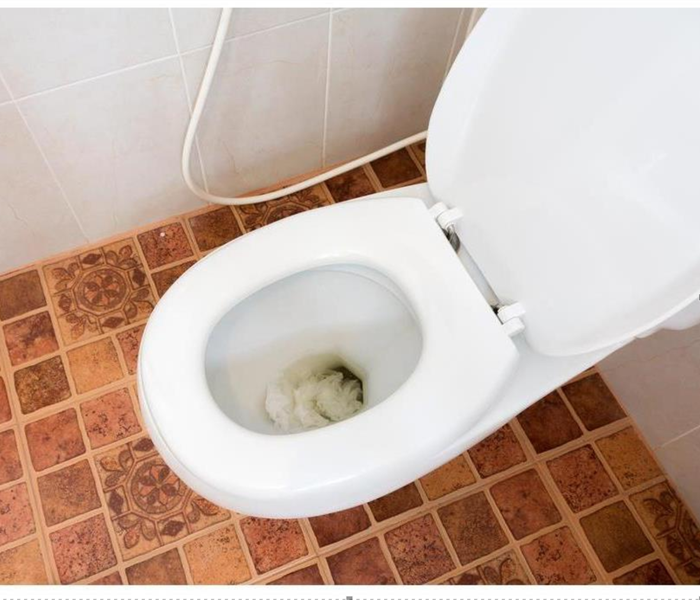 Clogged drains are easy to recognize and easy enough to fix.
Clogged drains are easy to recognize and easy enough to fix.
The Risk of Commercial Plumbing Issues
When you encounter plumbing problems, you could be looking at small problems or big ones. A clogged drain, for instance, is not the same as a broken pipe. Businesses in Baldwin, WI, and across the country would benefit from employing proactive methods of looking after their plumbing systems, diminishing the potential for future issues. Here are three proactive ways to ensure your commercial plumbing system keeps working properly.
1. Check Your Drains Often
Clogged drains are easy to recognize and easy enough to fix. When you see water beginning to back up in the toilets or sinks, you could employ a chemical or chemical-free solution, a wire hanger or a plunger. Typically, you'll pull out whatever's creating the clog, or the solution will flush it through the rest of the system.
2. Utilize Appropriate Water Pressure
If the water pressure in a building is too high, it could lead to broken seals, damaged fixtures and leaks. High water pressure applies stress to the pipes, but you can monitor it by attaching a hose bib gauge to your outside spigot. You're looking for water pressure between 40 and 80 psi. If you get readings above 80, you may want to install a pressure reducer.
3. Find a Plumber Who Is Versed in Various Plumbing Problems
Eventually, your plumbing system will alert you that something is wrong. The rule of thumb is the faster the fix, the better, but plumbing systems are complex, and most of their components are hidden. A trusted, experienced plumber can recognize issues quickly and prevent a small issue from affecting the rest of the system. If, for instance, your water bills are higher than normal and there are soft, mushy spots on the lawn, you may or may not consider a broken water main, but your plumber will likely pin it down immediately.
In the event of broken pipes or high water pressure, you'll need water damage restoration professionals. In the meantime, employing a proactive approach to your commercial water system can reduce your risk of experiencing plumbing problems.
Common Places Mold Grows in Commercial Buildings
6/13/2022 (Permalink)
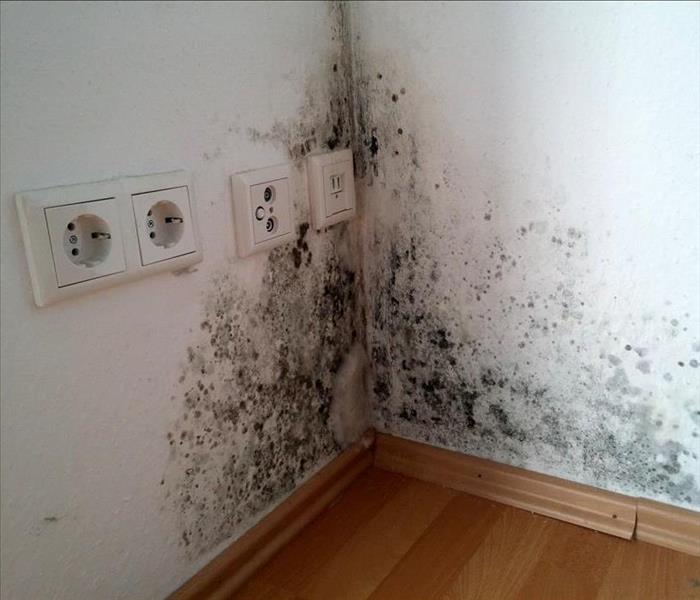 Mold damage in a commercial building in Hudson, WI.
Mold damage in a commercial building in Hudson, WI.
Common Places Mold Grows in Commercial Buildings
It does not take much for mold growth to occur. Mold is often found in dark, isolated spaces plagued by moisture. Mold can be costly and time-consuming to clean. The best defense against mold is to do everything possible to prevent it from ever happening. Here are a few places to check for mold in your building in Hudson, WI.
Common Places You Expect To Find Mold
Moisture, a surface, darkness, and organic nutrients from dust are all that is needed for mold to grow. Any area that has frequent exposure to water or high humidity can easily become infested with mold. Places you might expect to find mold include:
- Bathrooms
- Kitchens
- Carpets
- Windows
- Water heaters
- Air conditioners
Mold may not be out in the open in these areas. Remember that it thrives on darkness. Look under carpets, behind doors, inside devices, and within any cracks and crevices if you smell or otherwise suspect mold.
Places You May Not Think To Look For Mold
The common places you expect to find mold are the places you expect to find water and moisture. The places you may not think to look for mold are the areas of your building you do not associate with water at all. Areas that are rarely seen and are only occasionally inspected are common spots for overlooked mold growth. As these areas are left unchecked for long periods of time, unknown water damage can quickly turn into mold. Ceiling tiles, wall cavities, and wallboard damaged by leaks can easily become infested with mold. They are rarely explored and provide dark, enclosed environments. Ductwork and electrical equipment exposed to moisture or humidity can provide ample places for mold to grow.
Mold growth is pervasive and silent. It can spread before you realize that it exists. Conduct regular inspections of your building to keep mold at bay. A mold restoration specialist can help with cleaning and mitigation of the problem, but once mold is found, it is virtually impossible to eradicate.
How To Prepare Your Business For Hail Damage
4/23/2022 (Permalink)
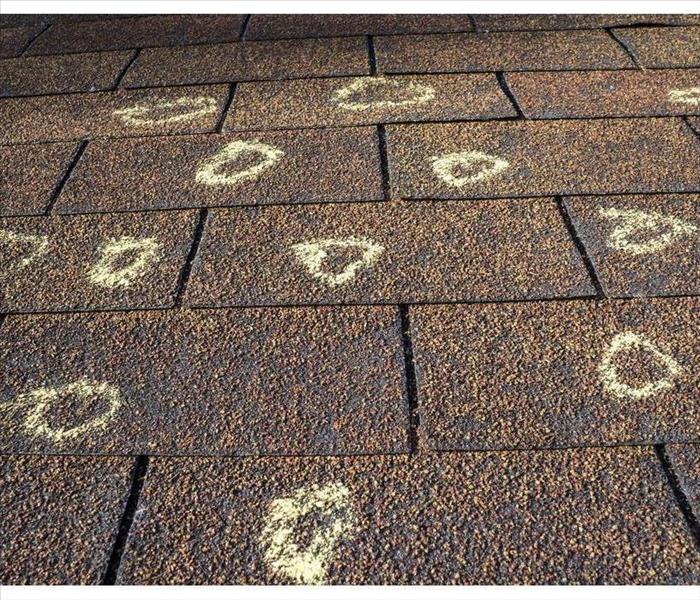 Regular maintenance can help prevent severe roof damage.
Regular maintenance can help prevent severe roof damage.
Owning a business comes with many responsibilities, not the least of which is maintaining your commercial property. Along with regular building maintenance, have a plan in place in case of natural disasters, such as hail storms. Here are a few things you can do to prepare for possible hail damage.
Know the Common Types of Hail Damage
Think through potential types of damage so you can make sure you have each one covered. Here are a few common types:
Roof Damage: This is a very common area of hail damage. Be sure to have your roof regularly inspected and repaired, especially after a hail storm. Regular maintenance can help prevent severe roof damage.
Glass Damage: If you have skylights, be sure that they are impact-resistant. Windows can be at risk too, depending on the angle of the hail coming down. Consider using impact-resistant glass here as well.
Property Damage: Hail can also cause damage to the property surrounding your building. This could include trees, HVAC units, or even commercial vehicles kept on your property.
Make Sure You are Covered
Once you have reviewed potential sources of storm damage, make sure that you have adequate commercial property insurance. This type of insurance will cover the financial impact of storm-related damage, which is an important protection for the financial health of your company. In the event of storm damage, initiate a claim with your insurance company and request authorization for a Roberts, WI, storm damage company to come in to do repairs. You don't want to be left with roof damage or other property damage impeding your ability to get back to business.
Protect Employees
Have an emergency plan in place to make sure employees stay safe in the event of a hail storm. Designate a gathering area safely away from windows, and communicate a procedure to follow with your employees. Consider practicing emergency drills.
No one wants to think about their business suffering storm damage, but early preparation can save a lot of hassle in the event of damaging hail. Make sure you have your bases covered to protect your property, your employees and your hard work.
What Is a Preferred Vendor?
4/13/2022 (Permalink)
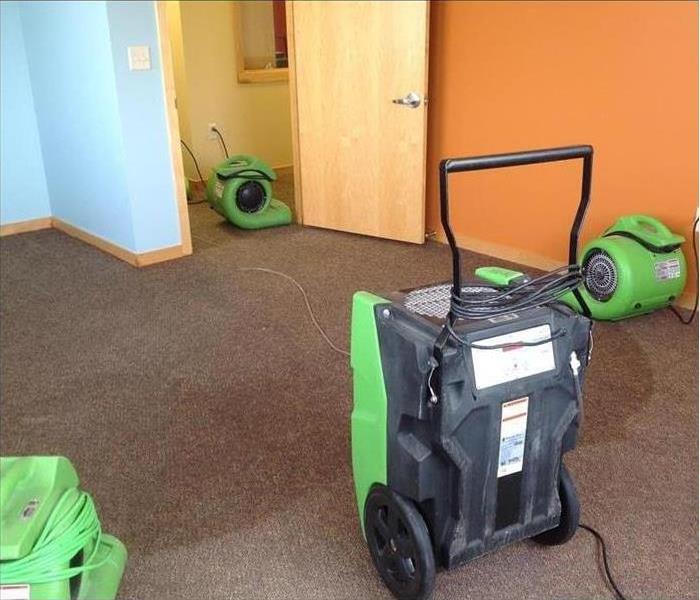 Office drying in Bay City, WI.
Office drying in Bay City, WI.
With a big commercial disaster claim, there’s often a lot on the line. Everyone involved, from the property manager to the business owner to the commercial property insurance agent, has an interest in making sure that the restoration work is completed competently, on schedule, and at a fair price. In many cases, this is most easily accomplished by using the insurance company’s preferred vendors.
What Is a Preferred Vendor?
Insurance companies have extensive experience handling disaster-based claims and working with various disaster recovery companies. Over time, some restoration companies begin to stand out as consistently delivering quality work and reasonable estimates on time. Insurance providers often designate such restoration companies as “preferred” vendors.
How Does a Preferred Vendor Program Work?
Most commercial insurance companies have some sort of process for selecting vendors for preferred status. Typically, these vendors must meet exacting guidelines for quality and performance to be selected as preferred vendors. Insurance companies ordinarily monitor these vendors to ensure that they continue to consistently meet these standards and maintain compliance with all requirements. For an insurance agent, working with a preferred vendor usually means a shorter turnaround time for approving estimates, since the vendor’s billing practices have already been approved by the insurance provider.
How Does SERVPRO Ensure Compliance?
SERVPRO is not only one of America’s largest restoration companies, but also has some of the industry’s highest internal performance standards. Every franchise must comply with 21 different performance guidelines, covering such matters as:
- minimum insurance requirements
- employee background checks
- bookkeeping and data reporting procedures
- equipment training and maintenance
These extensive requirements help ensure that every franchise continues to live up to the company’s high standards for quality and professionalism.
In the aftermath of a disaster in Bay City, WI, working with a respected and reliable preferred vendor typically makes things easier for the assigned insurance agent. The result is that restoration begins sooner, which is good news for the property owner as well.
3 Helpful Things To Know About Flood Insurance
2/28/2022 (Permalink)
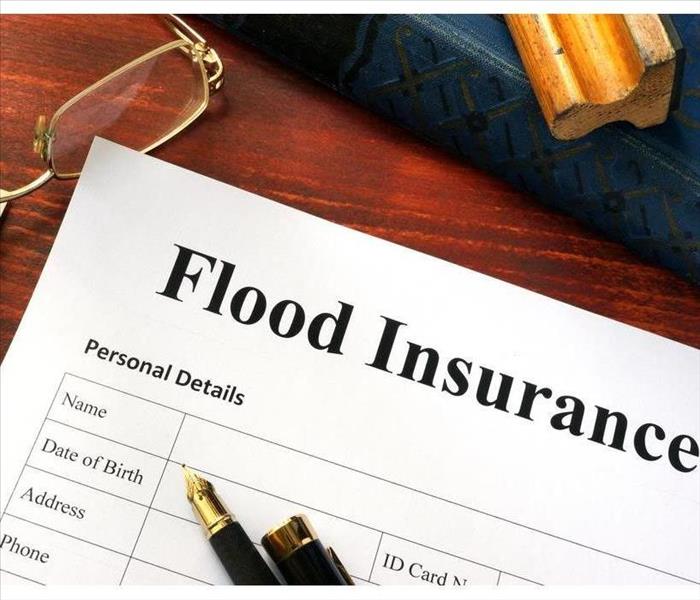 Flood insurance is a good choice for your property.
Flood insurance is a good choice for your property.
Flood Insurance
When looking at commercial insurance policies for a Hudson, WI, business, many company owners may be wondering if flood insurance is a good choice for their property. Here are a few things to consider.
1. What May Be Covered
In most cases, a flood policy will cover damage caused by nature or accidents. This usually includes incidents such as a broken pipe or sewer backup, along with rain overflow and other storm damage. It is the policy holder’s responsibility to know exactly what their plan covers, but most normal flooding falls under these categories. In many cases, the insurance provider may also cover the cost of repair and cleanup, as well as recommend a professional restoration service.
2. What May Not Be Covered
Many commercial insurance policies will not cover flooding that comes as a result of neglect. This means that if you knew one area needed repairs, you failed to take action, and flooding occurred as a result, then your insurance provider may decline coverage.
3. What a Restoration Company Can Do
Insurance providers may have recommendations for a restoration company that may be able to help. A professional restoration service is equipped to help with large-scale disasters according to FEMA guidelines. They also offer services such as electronic inventory management system, which can be used to document items and repair requirements as they go. The database can be updated by the restoration team and accessed by the insurance agents allowing them to have the most up-to-date information as they keep track of the claim.
When looking at their commercial insurance policy, it's up to the policyholder to know what exactly is included. In most cases, flooding caused by accidents or natural disasters will be covered. Flooding caused by neglect, however, probably will not. A professional restoration team may have the tools necessary to work with the insurance company in order to help process the claim and keep all required information updated.
Storm Preparedness Tips for Business Owners
1/31/2022 (Permalink)
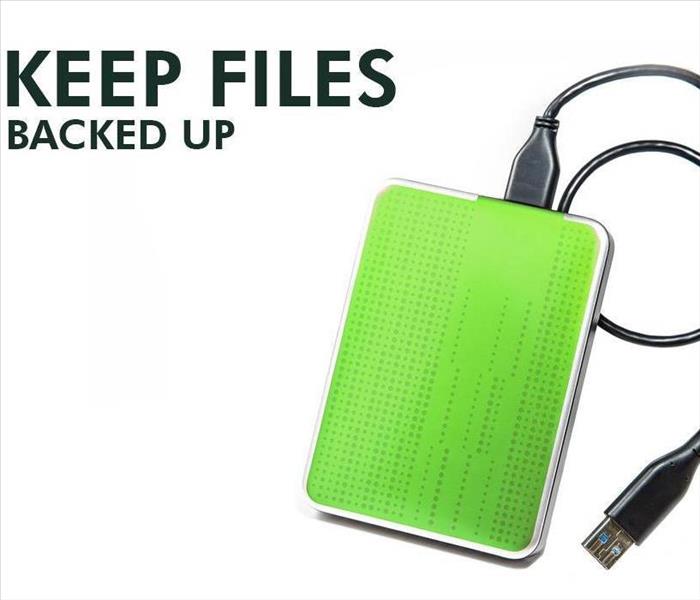 Make sure to back up important files.
Make sure to back up important files.
Storm Preparation Tips
Any commercial property owner in Bay City, WI, knows that hurricane damage is devastating. Even businesses further from the coast are susceptible to the impact of high winds and severe storms. Unfortunately, you cannot prevent Mother Nature from inflicting mayhem. Here are some storm preparation steps to protect yourself and your investment.
Have a Safety Plan
In an emergency, the priority is the safety of your employees and yourself. Prepare ahead of time by setting and practicing evacuation and shelter-in-place procedures. Always have these items accessible:
- Fire extinguisher
- Basic tools, including flashlights
- Emergency numbers
- First aid kit
- Bottled water and non-perishable food
- Blankets
Protect Important Records
Hurricane damage can involve high winds and flooding. Water may destroy papers and electrical equipment, such as computers. Prior to a storm threat, take the time to safeguard critical business documents.
• Back up data files regarding employee records, tax information, insurance policies, customer information and inventory. Keep backed up material secure at an off-site location.
• When possible, house on-site paper records in water- and fire-resistant containers.
Prepare Your Structure
During a hurricane, winds can blow at speeds of 74 mph to 215 mph. It is difficult for a building to withstand such weather. Before a tropical storm or another event, put measures in place to prevent and mitigate damage, should it occur.
• Maintain the property year-round. Have the roof inspected and clear overgrown foliage.
• When a storm is imminent, board the windows, move electronics and valuables to a higher floor, sandbag the area and secure furniture.
• After the weather event has ended, contact a storm restoration specialist as soon as possible to evaluate the damage and begin the mitigation and restoration process.
Hurricane damage at your business in Bay City, WI, can be devastating. However, you can minimize the impact by being prepared. Have a safety plan, protect your documents, stormproof your property and contact a restoration professional immediately in the aftermath.
How To Mitigate Water Damage
12/30/2021 (Permalink)
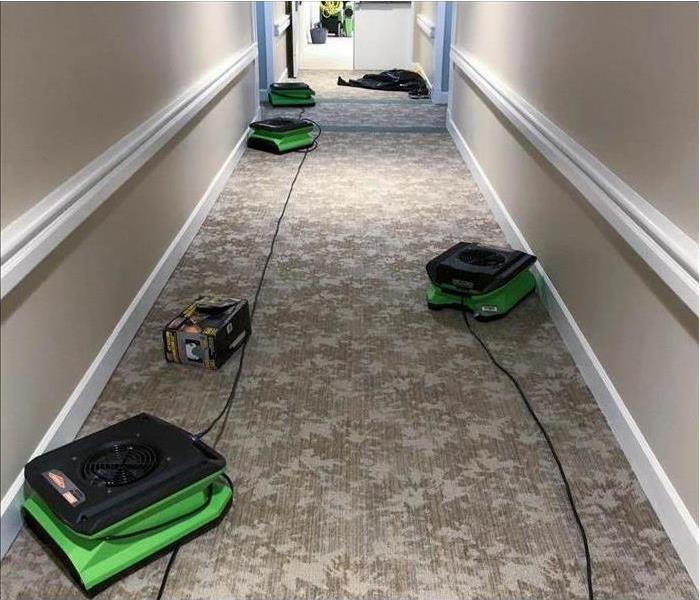 Dry the area regardless of the category of water damage.
Dry the area regardless of the category of water damage.
Water Mitigation
Mitigation should begin as soon as a property owner or manager notices signs of water damage. Whether you discover a supply line leaking or you need a pipe burst cleanup, these water cleanup measures can limit the severity of damage.
Address the Cause
Damage is likely to worsen until the cause is fixed. Take the following mitigation measures:
- Turn off the water supply
- Collect water in containers
- Contact a plumber
These steps can limit the severity of water damage. Once the problem is fixed, cleanup can proceed.
Remove Standing Water
Water left standing will damage contents. Depending on how much water is present, you may need to use towels and a mop, a wet vac, or a pump. If you do not have equipment capable of handling a pipe burst cleanup, contact a water damage cleanup service. Mitigation professionals can quickly address primary and secondary damage.
Clean and Disinfect
It may be necessary to clean or disinfect the damaged area. The treatment required depends on conditions where the leak occurred and the category of water damage. You will need to
- Dry Category One damage
- Clean and disinfect Category Two damage
- Clean and disinfect Category Three damage
Category One water is clean and treated. Category Two gray water is contaminated but does not contain solid waste. Category Three black water is highly contaminated and may contain sewage.
Dry the Area
It is necessary to dry the affected area regardless of the category of water damage. You may use air movers, dehumidifiers, or fans. This equipment will promote faster drying and draw moisture out of porous surfaces. Drying can limit the severity of water damage.
The owner or manager of a commercial property should fix the cause of water damage as soon as possible. If pipe burst cleanup or other major mitigation measures are necessary, hire a water cleanup service located in Star Prairie, WI.
Basic First Aid for Workplace Burns
10/12/2021 (Permalink)
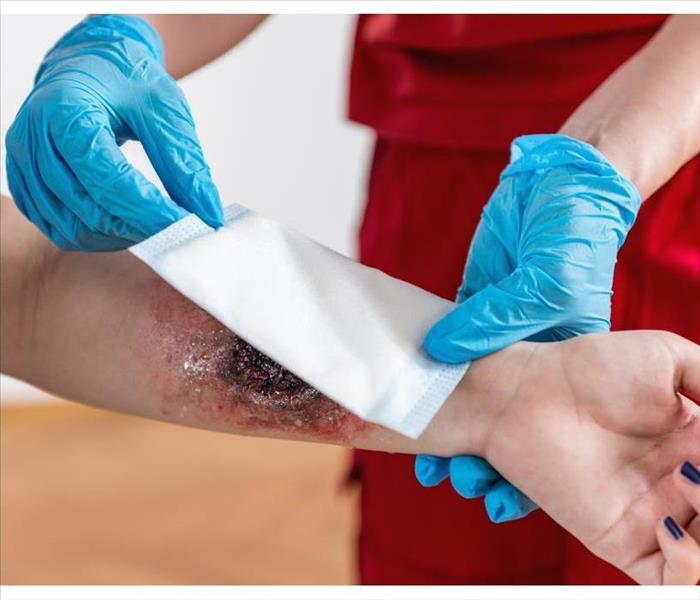 First aid training - Burn Injury
First aid training - Burn Injury
Workplace Burns: Basic First Aid
When fire accidents happen around the workplace in New Richmond, WI, it isn’t only fire damage to your property you need to worry about. To improve safety conditions, all employees should understand basic burn first aid. Minor burns can be managed on site, but more serious burns need to be treated by a doctor. If a burn meets any of the following criteria, call for emergency help right away.
- Appears charred
- Has white, brown or black patches
- Is larger than three inches across
- Covers hands, face, feet, buttocks, groin or joints
- Is deep
Treating Minor Burns
If fire damage to the skin affects a small area and appears red or blistered, it’s probably minor enough to treat on-site. First, run the burn under cool water or hold cool, wet compresses against it to reduce the pain. If there is any jewelry in the burned area it should be removed, because burns can swell and cause jewelry to become painfully tight. A burn lotion, such as aloe vera, can be applied and a dry gauze bandage wrapped loosely around the area. Try not to break any blisters, as these protect the burned skin from infection. If a blister does break, gently clean it and cover the area with gauze.
Handling Major Burns Until Help Arrives
If an employee sustains major burns, there are things you can do to treat the burn until emergency services arrive. The most important thing is to get the injured person away from the heat source and to check to see if they are breathing. If not, begin resuscitative breathing immediately. The following actions can prevent further harm until trained medical personnel can take over.
- Remove restrictive items, such as jewelry and belts, from the burned area
- Cover the burn with cool, damp cloth
- Elevate the burned area
- Treat for shock by lying the person down, elevating their feet and keeping them warm
While fire damage to property should only be handled by a professional fire remediation company in New Richmond, WI, every worker should be trained in basic first aid for burns. Addressing a wound right away can make a big difference in the healing process.
Understanding Commercial Floor Cleaning and its Benefits
4/9/2021 (Permalink)
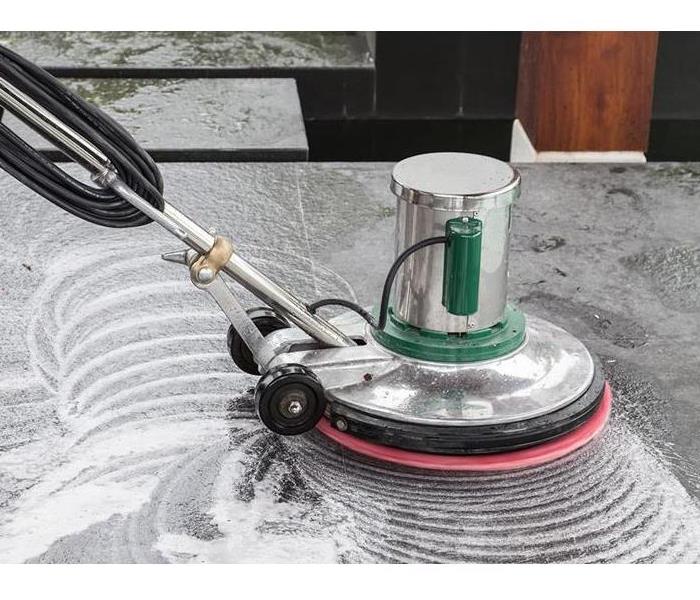 It can be easy to take floors for granted when it comes to a comprehensive cleaning and maintenance plan for your facility
It can be easy to take floors for granted when it comes to a comprehensive cleaning and maintenance plan for your facility
It can be easy to take floors for granted when it comes to a comprehensive cleaning and maintenance plan for your facility. However, floors are just as important as any other part of a building, if not even more so.
Clean and shiny floors are a key aspect of any well-maintained building and successful business. However, over time, floors can easily become scuffed, worn, and permanently dirty. This can happen sooner if routine floor care and maintenance is neglected.
What is Floor Stripping and Waxing?
Many hard floors, such as linoleum, acrylic, hardwood, and vinyl have a special wax coating to keep them shiny and make them easier to clean. The wax protects the flooring from dirt, debris, scratches, and cracking.
Stripping is the process of completely removing the preexisting wax coating, while waxing refers to re-applying a fresh coat of wax finisher. Stripping and waxing can be a difficult undertaking without the correct training, tools, and materials, so hiring a commercial floor cleaning company is strongly advised.
Benefits of Hiring a Commercial Floor Cleaning Service
Not only is the process itself rather involved, but proper personal protective equipment (PPE) is also required, which may not be readily available given our current public health crisis.
To properly strip and wax a floor, expensive appliances and tools are needed, including a floor scrubber, a wet-dry vacuum, and a floor buffer. Unless you are a commercial cleaner, you likely do not have these items at your facility.
Furthermore, it is important to consider the potential cost if the process is performed incorrectly. If a floor cleaning project goes awry, there could be potentially irreparable damage to already expensive floors, massive inconveniences to everyone involved, and an even bigger financial burden by having to replace sections of the floor, or even the entire floor.
Stripping and waxing a floor is something that can be done by someone on your team, but hiring an industrial floor cleaning service would be a safer and more cost-effective solution.
Disaster Shut Down
4/2/2021 (Permalink)
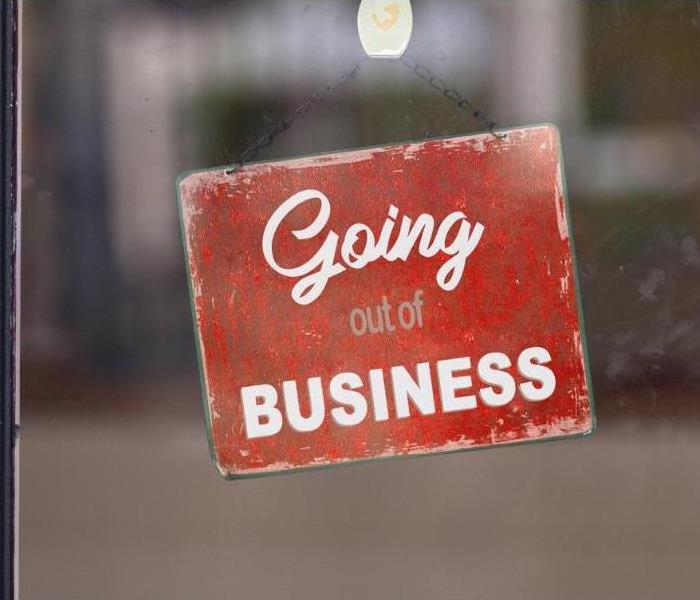 There’s never a convenient time for a disaster to strike.
There’s never a convenient time for a disaster to strike.
When you own a business, there’s never a convenient time for a disaster to strike. Fire, flooding, or destruction from a natural disaster can take time to mitigate and should be dealt with immediately before the damage spreads. Once the immediate danger is handled, cleanup and restoration of the damage can begin. In a world where time means money, any amount of downtime can put your business at risk of lost revenue and productivity. Remember, every hour spent cleaning up and repairing damage is an hour of opportunity lost for your business.
If you are a small business and have limited resources, it can be difficult to recover from a disaster, especially when it interrupts your daily operations. However, with the support of the right disaster commercial recovery team and a comprehensive recovery strategy, you can get back to business faster.
Be Prepared Before an Emergency Hits
According to FEMA, almost half of all small businesses affected by a disaster will never re-open their doors. For those that do, 90 percent will fail within a year if they don’t resume their operations within five days of the damage occurring. Why is that? Depending on the type and extent of damage, general operations may have to stop within the affected area. Meanwhile, life as usual goes on for customers and clients who are not directly impacted by the disaster. While some may be willing to wait for the business to reopen its doors, any long-term business disruption can send customers and clients looking elsewhere to get their needs met.
Businesses, large and small have a better chance of recovering from a disaster and successfully returning to business as usual if they have a plan before disaster strikes. Even when a disaster plan does exist, only 80 percent of companies spend time re-evaluating their plan each year. If you do not have one, it’s time to create one, so your business can go on as usual in the event of an emergency.
Creating a Emergency Response Plan (ERP)
If a fire, flood, or natural disaster were to occur, would you know who to contact to save your business? Regardless of the size of your business, having a ERP for your business will give you a roadmap to recovery if an emergency occurs. This plan will help you save time and limit your property losses by saving as many assets as possible. It includes:
commercial services - commercial space with painters plastic hanging in windows
Compiling a list of emergency contacts, including phone numbers and addresses.
Phone calls
E-mails
What is Involved in Commercial Restoration?
SERVPRO of The Saint Croix Valley offers multiple restoration services to our commercial clients, including:
Emergency mitigation services to protect remaining business assets and building from secondary damage
Stabilization of building
Boarding-up your facility
Drying and dehumidifying your building
Recovering documents
Restoring electronics and wiring
Restoring your location to preloss condition
Reconstructing your building
10 Tips to Keep Your Office Space Clean
4/2/2021 (Permalink)
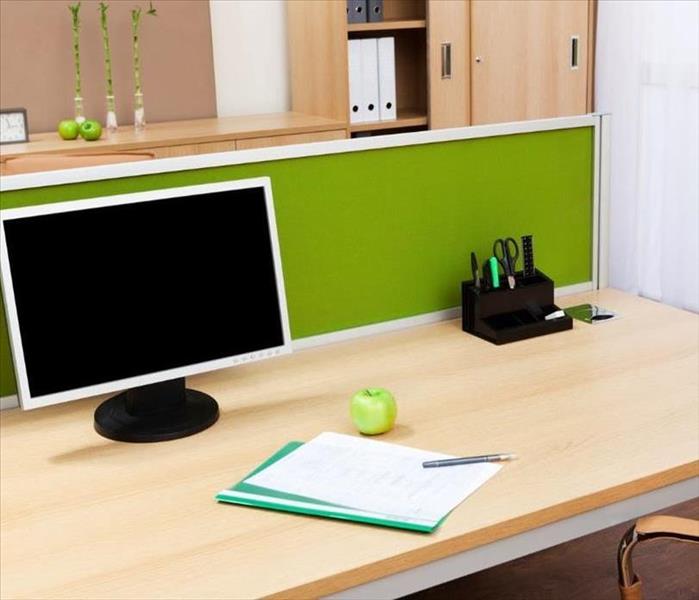 Maintaining a clean work space means a healthy environment for your employees and a presentable establishment for clients.
Maintaining a clean work space means a healthy environment for your employees and a presentable establishment for clients.
Maintaining a clean work space means a healthy environment for your employees and a presentable establishment for clients. Avoid germ buildup and dirty spaces with these simple tips to keep your office space clean.
Desk Duty
All the hustle and bustle of a busy workday usually leads to a cluttered desk. Take some time at the end of your day to clean your desk area. Straighten out office documents and throw excess papers, food wrappers and other trash away.
Avoid Food Messes
When work gets busy, it’s easier to stay at your desk and have lunch while typing away on your computer. Eating at your desk, however, guarantees a messy workspace as crumbs and even liquids fall into the crevices of your keyboard or stick to the desktop. Over time, stains become harder to remove and bacteria begins to accumulate.
Kill the Germs
If eating at your desk is your thing, then make sure to maintain a healthy work environment. Dust and other particles accumulate overtime. Wipe those germs away at least once a week with a quick wipe down of your desktop with a multi-purpose cleaner.
Antibacterial is Your Best Friend
Germs spread fast in any environment. You’ll want to keep hand sanitizers in stock and easily available to avoid the spread of germs. The last thing you want is for the entire office to come down with a stomach bug, flu or cold.
Group Effort at Play
Break rooms or common areas should be cleaned regularly to avoid germ buildup. As a place where all workers spend time, don’t shy away from maintaining this area. Avoid leaving dishes in the sink, throw out old takeout from the refrigerator and sanitize the countertops.
Trash Duty
If your office doesn’t have a daily janitorial service, make sure to empty your trash every night or every other night so bacteria and odor don’t become a problem. Make this a group effort. Designate a different work associate to take care of the trash on certain days.
Get Those Hard to Reach Places
When it comes to a full office cleaning, make sure all spaces are accessible. You may consider rearranging office furniture to avoid hard-to-reach places, like large gaps behind filing cabinets or sofas.
Carpet and Tile Cleaning
With paperclips, staples and papers, office floors can get pretty dirty. Whether you need to vacuum or mop, keeping the office floors clean makes your workspace safe and presentable for clients and visitors.
Do Your Part
Your area is your responsibility. Take the time to ensure it is maintained on a day-to-day basis. Office cleanliness is a group effort that can be made easy when everyone participates.
Commercial Water Damage Restoration Explained
4/1/2021 (Permalink)
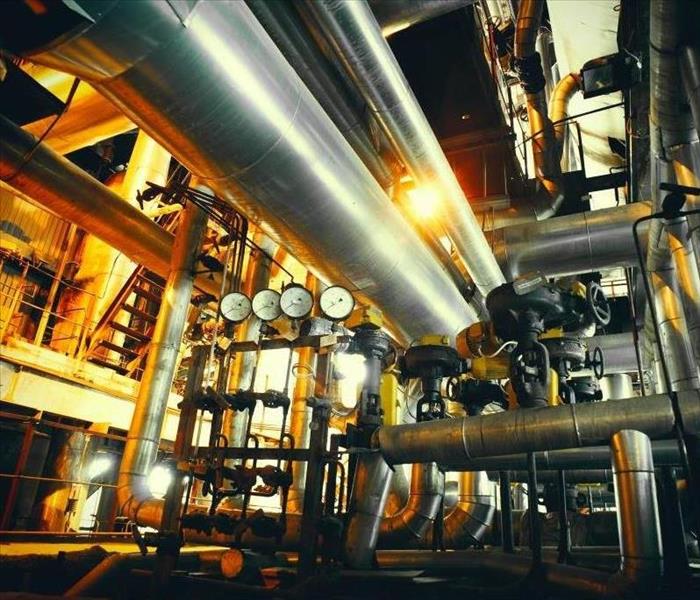 Water damage can strike your commercial building at any given time.
Water damage can strike your commercial building at any given time.
Commercial Water Damage Restoration Explained
Water damage can strike your commercial building at any given time. Depending on the severity, it can leave devastating effects and financial burdens. Despite the unpredictability of disaster, understanding the basics of commercial water damage restoration can help you prepare your business and minimize damage. Find out what to do when you discover water damage, the risks associated, and how to find the right service provider for you.
Contacting Commercial Restoration Services for Water Damage
Disaster is inherently hard to plan for, but when it strikes, time is of the essence. You must act fast when dealing with water damage. Whether it’s from a sewer backup, burst pipes, flooding, or a natural disaster, it can leave your facility unfit for business. Water may seep into your ceiling, walls, and underneath carpet or floors. If left untreated, more damage accrues and continues getting worse over time.
If your business has water damage, it’s crucial to act quickly. Contact a local commercial restoration service provider. A reputable provider can provide timely emergency service assistance. Usually, they’ll arrive within hours. Until then, carefully assess any building damage and potential hazards. If possible, try to identify the type of water loss. Doing so helps your contractor prepare by knowing which water removal equipment to bring ahead of time.
Potential Risks of Commercial Water Damage
Taking the above measures and quickly getting in touch with a specialist is crucial to minimizing damage to your facility and keeping the area as safe as possible. Standing or rising water can quickly spread from room to room and destroy everything in its path. In a matter of minutes, your flooring and upholstery may all suffer permanent damage. Soaked wooden structures can also warp or split, leading to broken door frames and windows.
Mold growth is another common offender in water-damaged buildings. Mold can cause health effects.
Choosing the Right Commercial Water Damage Restoration Specialist
Every day spent restoring your commercial property is another day of lost earnings. Therefore, we recommend working with an experienced restoration company. Treating water damage promptly and thoroughly is the best way to prevent lasting damage. No matter if it’s from a plumbing leak or storm damage, a trusted commercial restoration service will quickly stabilize your property.
Flooded facility in need of commercial water damage restoration
After getting things under control, most water damage restoration specialists dry and clean your damaged building structures. Using dehumidifiers and heavy-duty drying equipment is essential for stopping mold growth. As they assess your building, any leftover items will be removed or salvaged.
Your insurance company may also contact you to fill out insurance paperwork. Fortunately, you don’t have to manage your claims alone. The J.C. Restoration team can assist you with this step to make the process as stress-free as possible.
THE CAUSES OF COMMERCIAL WATER DAMAGE AND HOW TO DEAL WITH THEM
4/1/2021 (Permalink)
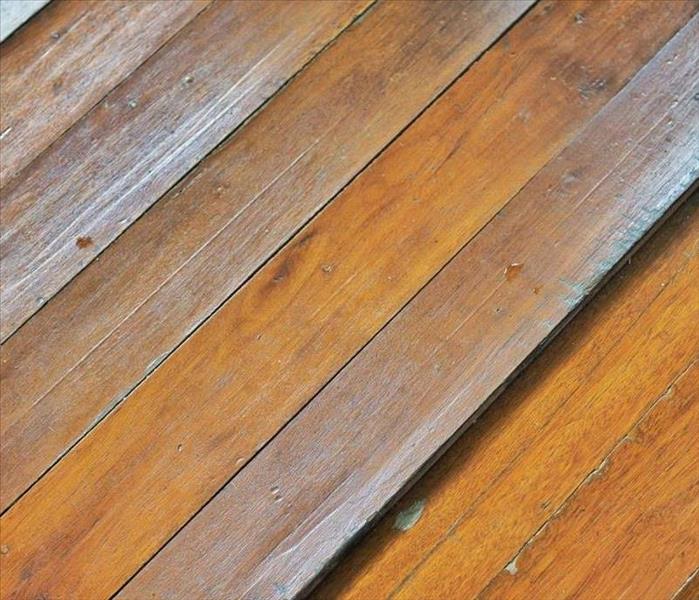 Water damage in the workplace may not only prevent you from doing business.
Water damage in the workplace may not only prevent you from doing business.
Water damage in the workplace may not only prevent you from doing business. It can also put the health and safety of your employees at risk. The moment you spot signs of commercial water damage, it’s important to take action immediately.
Commercial water damage restoration is often more complex than residential water damage restoration and usually requires an intensive approach. The size and structure of commercial buildings, the extent of damage, the varying uses of space, and the number of occupants all affect the restoration process. Aside from these, there’s usually always a time constraint for the job because business has to continue as soon as possible.
While some water damage issues are inevitable, most problems can be prevented when the cause of water damage is found earlier.
In this post, we’ll talk about the most common causes of water damage in commercial properties and how to deal with them.
CAUSES OF COMMERCIAL WATER DAMAGE
Here are the common causes of commercial water damage:
DAMAGED WINDOWS
In commercial buildings, water damage is often caused by windows that are not properly sealed. Damaged windows can cause moisture to seep in, which triggers a lot of problems including mold build-up and warped wood and drywall. Resealing windows regularly is important as caulk can break down over time.
DAMAGED PIPES
Causes of Commercial Water Damage
Broken pipes can stem from many reasons, such as changes in pressure, deteriorated water supply lines and sewer drains, and cold weather (freezing temperature can cause pipes to burst). Bulging walls, water stains on walls or floors, cracked or loose tiles, and musty smell – these are all signs of damaged pipes. Detecting leaky pipes is challenging and it usually requires some specialized water leak detection equipment.
BUILDING FOUNDATION
If gutters are not cleaned regularly, they can get clogged, causing water to leak into the property through the roof or the foundation. One of the most common signs of leaks in building foundations are puddles nearby or framing that has become wet. Poor drainage systems can also lead to water damage in your foundation.
ROOF LEAKS
A leaky roof can cause ceiling damage, mold or mildew issues, fire hazards from shortened wires, and compromised structural integrity. Exposure to heavy rains and snow make roofs vulnerable to damage. Moreover, incorrect snow/ice removal can also trigger water damage in roofs.
HVAC PROBLEMS
HVAC systems work by heating or cooling the air through a series of ducts. Over time, these ducts wear out and get damaged, resulting in leaks. The HVAC system needs to be cleaned regularly and the excess water from the condensation reservoirs has to be removed to prevent water damage.
SEWER CLOGS
Sewer water contains bacteria and other pathogens that cause illnesses and infections. If you see signs of sewage damage, such as gurgling sounds or water backing up out of the drain or toilet, you should call water damage and restoration professional immediately.
SPRINKLER SYSTEM LEAKS
Other causes of water damage in commercial buildings are leaks in sprinkler systems. Signs of sprinkler leaks include wet surfaces like drywall and carpets, presence of mold and mildew, and standing water. Regularly inspect your sprinkler systems for leaks and moisture.
COMMERCIAL WATER DAMAGE PREVENTION
Commercial water damage restoration
Taking the necessary measures to prevent water damage can save you from costly repairs and business interruption in the future. Since water damage can come from a variety of sources, it’s essential to have the building inspected regularly to prevent leaks and related issues.
CREATE A FLOOD MONITORING SYSTEM
Regardless of whether your business is located in a flood-prone area, make sure you have an efficient flood warning system in place. Flooding can result from other causes, including plumbing failures, overflowing rivers, and melting snow.
GET ENOUGH COVERAGE FOR YOUR PROPERTY
Flooding is not usually included in property insurance policies. Water damage restoration can be very expensive. Water damage insurance can you deal with the costs if ever your property gets damaged by a flood in the future.
CONDUCT A WATER DAMAGE INSPECTION REGULARLY
Water damage prevention is a lot cheaper than restoration. To prevent water damage from getting worse, have professionals inspect your property at least once a year. Leak detection is performed in several ways, such as humidity monitoring and the use of spot sensors.
INVEST IN FACILITY MAINTENANCE
A preventative maintenance plan should keep your commercial building safe and secure and contribute to your water leak prevention efforts. Different parts of a commercial building should be inspected at different intervals. For example, doors, windows, and gates should be checked each year for weariness while the roof can be coated every five years or so to prevent damage.
COMMERCIAL WATER DAMAGE AND MOLD
Commercial Water Damage and Mold
Water damage and mold go hand in hand.
One of the most common effects of water damage in commercial buildings is mold and mildew build-up. It only takes 24-48 hours of exposure to water damage before these dangerous microorganisms start growing.
To stop mold growth, the source of water damage should be fixed right away. It’s to hire emergency water damage restoration professionals to conduct commercial mold cleanup and mold mitigation to ensure that no trace is left.
COMMERCIAL WATER DAMAGE RESTORATION
Commercial water damage restoration is a job that is handled by professionals. Make sure to hire restoration contractors who have water damage restoration certification, like SERVPRO.
5 Quick Cleaning Tips That Can Boost Productivity at Work
3/16/2021 (Permalink)
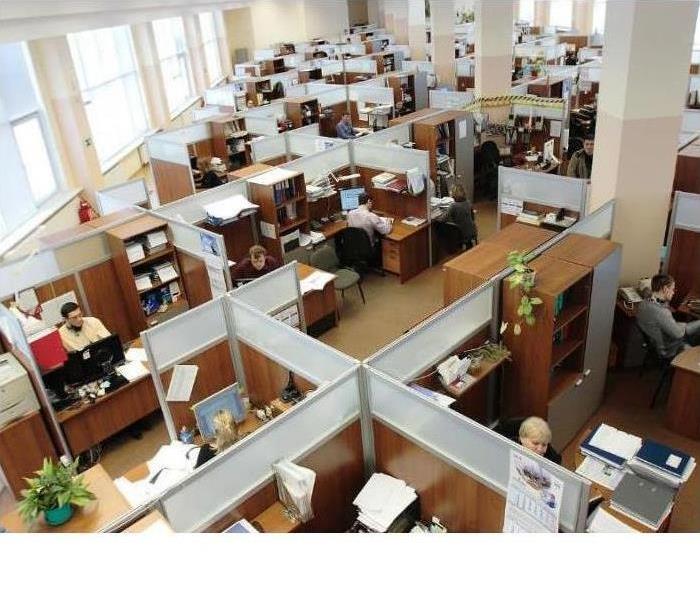 It’s a well-known fact that a neat and tidy office increase productivity.
It’s a well-known fact that a neat and tidy office increase productivity.
It’s a well-known fact that a neat and tidy office increases productivity. Not to mention, keeping your office clean of germs will discourage employees from calling in sick. Giving your office a deep Spring Cleaning will help boost your productivity and give your office the look it needs to attract the best customers.
If you are looking to clean your office yourself, these are the top 5 things you can do to keep your office clean in order to ensure and increase productivity.
Clean your phones!
Phones are a cesspool of germs. When your employees get sick, productivity declines. If they miss work due to sickness, it becomes an even bigger problem. Cleaning your phones daily with an anti-bacterial wipe is the number one way to ensure phones are germ free and your employees are healthy.
Get rid of that smell!
Floors and carpets that are not properly cleaned will absorb bad smells. It’s proven that certain smells, such as orange, increase energy and productivity. Working in an environment that doesn’t smell good is a factor that declines worker morale. Cleaning and shampooing your carpets will guarantee this problem is corrected. You can rent a carpet vacuum and risk the chance of harboring mold under the damp carpets, or you can call a commercial cleaning service, who may be better equipped to handle that kind of situation.
Keep desks dust free!
Dust carries many allergies which cause a lot of people to get sick. Not to mention, working in a dirty space declines staff morale. Dusting your commercial space, as well as all of the desks every night is very important. It's also important to move all the supplies off a desk and wipe the desks once a week.
Sweep that floor!
Working in an office space that is cluttered or dirty does not help increase productivity. On the contrary, it decreases productivity. It is also something that may turn off prospective customers. Sweeping floors every night is imperative to having a clean and put-together office. First appearances are very important and if a customer sees a dirty floor, they may not trust your product or service.
Empty the trash!
Full trash cans attract little critters. Especially trash cans full of snack and lunch wrappers. Emptying the trash daily is very important when it comes to maintaining the productivity in an office. An employee working in an area that smells like a garbage bin won’t be as focused and productive as one working in an office with fresh air.
SERVPRO ERP, the Bridge to Your Business Continuity Plan
3/12/2021 (Permalink)
 SERVPRO offers all commercial, educational, and governmental buildings a free Emergency Readiness Plan.
SERVPRO offers all commercial, educational, and governmental buildings a free Emergency Readiness Plan.
SERVPRO offers all commercial, educational, and governmental buildings a free Emergency Readiness Plan, which includes a walkthrough of the building and a report in both hard and digital copies. Which can be accessed on any mobile device, anywhere and anytime. 70% of businesses go out of business after a major disaster to the physical business, and of the 30% that make it through the disaster only half have some kind of plan in place. And that 50% is who this article is directed at.
When I sit down and chat with businesses, nursing homes, schools, city governments, or hospitals that all have some sort of plan in place they don’t initially see the value in having SERVPRO put together an ERP for them. That’s when I ask about their plan, and usually get the same types of answers: “Our employees will work remotely.” “Our residents and staff will be moved to another facility.” “Why reinvent the wheel?" And more answers along the same lines. All having to do with continuing work.
That’s when I ask the question, well how do you plan on stabilizing the building once the disaster is under control? How do you plan on securing the premises and contents of the building? What if you as the owner or decision maker aren’t available, will the employees know how to contact the next person in line, or your insurance agent. Do they even know where the binder with the master plan is kept, and if you are at the scene, will you be able to get to it. That’s why it’s nice to have an app on your phone that you can access with ease.
If a company already has a continuity plan in place, the SERVPRO ERP is a great bridge to get your organization stable and into the plan you have in place for situations that stop you from working as normal. The faster a damaged building can be secured and mitigation can be put in place, the more of the building that can be saved and the faster the reconstruction can begin. If your business does not already have a plan in place, the ERP is a great base to build your plan from.
We Had _________ Happen To Our Place of Business, What Now!
1/5/2021 (Permalink)
 Every business owner’s worst nightmare is something happening to the physical location of their company.
Every business owner’s worst nightmare is something happening to the physical location of their company.
Every business owner’s worst nightmare is something happening to the physical location of their company. The place where your inventory, records, or employees report for work each day. In a digital age, the brick-and-mortar location is still an important element of many companies. What happens when a sprinkler head breaks, or that bag of popcorn in the breakroom microwave catches on fire? Most businesses need to be in their facilities to conduct business, what’s your plan to get back into your building after an accident.
70% of businesses that go through some sort of disaster do not reopen. Of the 30% that do reopen, half had emergency readiness plans in place. It is hard enough to reopen a business after a loss, have you improved your odds by having a plan in place. If not, SERVPRO of the Saint Croix Valley can help put one in place. Our complimentary program, compiles the emergency contacts, shut offs and service entrances throughout the building. Along with any other information of value, to first responders or employees. The information is kept both in a hard copy, as well as, a mobile app on key employees’ phones. Faster response times are always critical in any emergency situation.
For our commercial insurance partners, teaming with SERVPRO to provide this plan is a fantastic way to give additional value and protection to your clients. Reach out today to schedule a time to put your plan into place.
Please follow our page, as we continue to explore the benefits of mitigation, and how this approach helps both your clients and your business. Please call us with any questions you have, 715-381-2266. Visit our site: SERVPRO of The Saint Croix Valley
Your Client Has A Property Lost – What Now? 1-4-8 Response Time
1/5/2021 (Permalink)
 In last week’s article we discussed the potential cost benefits of using a remediation company, what that mean.
In last week’s article we discussed the potential cost benefits of using a remediation company, what that mean.
In last week’s article we discussed the potential cost benefits of using a remediation company, what that mean. So, you have a client call in with a loss. That’s when our 1-4-8 service guarantee kicks in. Within 1 hour of receiving notice of loss your client will be contacted to determine scope of loss. Within 4 hours of that notice, we will have boots on the ground to visual determine the scope and begin necessary work to mitigate further loss. By the 8th hour, we will have spoken with you and your client to provide an update on how the course of action will proceed. Response time in any loss, be it fire, water, etc. is critical, when trying to salvage both building and personal materials. That’s why we are faster to any size disaster.
Please follow our page, as we continue to explore the benefits of mitigation, and how this approach helps both your clients and your business. Please call us with any questions you have, 715-381-2266. Visit our site: SERVPRO of The Saint Croix Valley
Disaster Shut Down
4/1/2020 (Permalink)
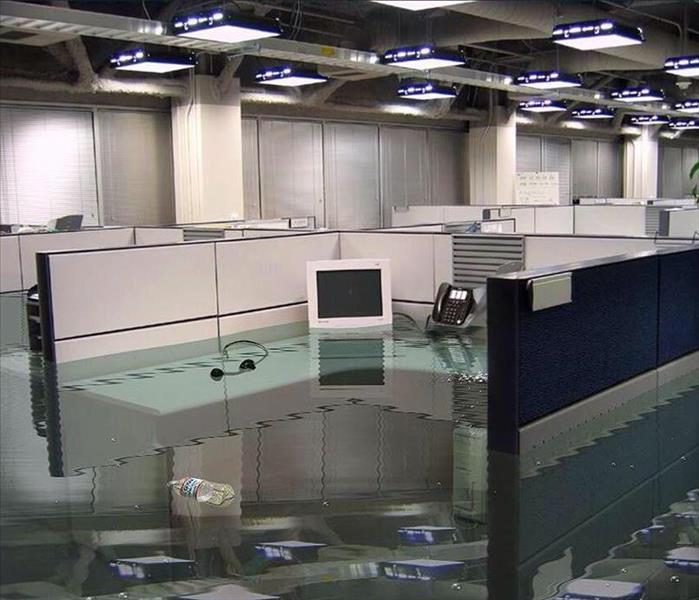 Don't get caught unprepared.
Don't get caught unprepared.
When you own a business, there’s never a convenient time for a disaster to strike. Fire, flooding, or destruction from a natural disaster can take time to mitigate and should be dealt with immediately before the damage spreads. Once the immediate danger is handled, cleanup and restoration of the damage can begin. In a world where time means money, any amount of downtime can put your business at risk of lost revenue and productivity. Remember, every hour spent cleaning up and repairing damage is an hour of opportunity lost for your business.
If you are a small business and have limited resources, it can be difficult to recover from a disaster, especially when it interrupts your daily operations. However, with the support of the right disaster commercial recovery team and a comprehensive recovery strategy, you can get back to business faster.
Be Prepared Before an Emergency Hits
According to FEMA, almost half of all small businesses affected by a disaster will never re-open their doors. For those that do, 90 percent will fail within a year if they don’t resume their operations within five days of the damage occurring. Why is that? Depending on the type and extent of damage, general operations may have to stop within the affected area. Meanwhile, life as usual goes on for customers and clients who are not directly impacted by the disaster. While some may be willing to wait for the business to reopen its doors, any long-term business disruption can send customers and clients looking elsewhere to get their needs met.
Businesses, large and small have a better chance of recovering from a disaster and successfully returning to business as usual if they have a plan before disaster strikes. Even when a disaster plan does exist, only 80 percent of companies spend time re-evaluating their plan each year. If you do not have one, it’s time to create one, so your business can go on as usual in the event of an emergency.
Creating a Emergency Response Plan (ERP)
If a fire, flood, or natural disaster were to occur, would you know who to contact to save your business? Regardless of the size of your business, having a ERP for your business will give you a roadmap to recovery if an emergency occurs. This plan will help you save time and limit your property losses by saving as many assets as possible. It includes:
commercial services - commercial space with painters plastic hanging in windows
Compiling a list of emergency contacts, including phone numbers and addresses.
Phone calls
E-mails
What is Involved in Commercial Restoration?
SERVPRO of The Saint Croix Valley offers multiple restoration services to our commercial clients, including:
Emergency mitigation services to protect remaining business assets and building from secondary damage
Stabilization of building
Boarding-up your facility
Drying and dehumidifying your building
Recovering documents
Restoring electronics and wiring
Restoring your location to preloss condition
Reconstructing your building
What Should You Do if a Disaster Shuts Down Your Business?
When disaster strikes in the Saint Croix Valley and surrounding areas, SERVPRO of The Saint Croix Valley is ready to get to work. As a leader in property emergency services, we can help your business overcome the devastating setbacks of property damage caused by fire, water, or other natural disasters. We can assist our commercial clients in preloss planning and project management in helping create a solid business disaster recovery plan.
10 Tips to Keep Your Office Space Clean
4/1/2020 (Permalink)
Maintaining a clean work space means a healthy environment for your employees and a presentable establishment for clients. Avoid germ buildup and dirty spaces with these simple tips to keep your office space clean.
Desk Duty
All the hustle and bustle of a busy workday usually leads to a cluttered desk. Take some time at the end of your day to clean your desk area. Straighten out office documents and throw excess papers, food wrappers and other trash away.
Avoid Food Messes
When work gets busy, it’s easier to stay at your desk and have lunch while typing away on your computer. Eating at your desk, however, guarantees a messy workspace as crumbs and even liquids fall into the crevices of your keyboard or stick to the desktop. Over time, stains become harder to remove and bacteria begins to accumulate.
Kill the Germs
If eating at your desk is your thing, then make sure to maintain a healthy work environment. Dust and other particles accumulate overtime. Wipe those germs away at least once a week with a quick wipe down of your desktop with a multi-purpose cleaner.
Antibacterial is Your Best Friend
Germs spread fast in any environment. You’ll want to keep hand sanitizers in stock and easily available to avoid the spread of germs. The last thing you want is for the entire office to come down with a stomach bug, flu or cold.
Group Effort at Play
Break rooms or common areas should be cleaned regularly to avoid germ buildup. As a place where all workers spend time, don’t shy away from maintaining this area. Avoid leaving dishes in the sink, throw out old takeout from the refrigerator and sanitize the countertops.
Trash Duty
If your office doesn’t have a daily janitorial service, make sure to empty your trash every night or every other night so bacteria and odor don’t become a problem. Make this a group effort. Designate a different work associate to take care of the trash on certain days.
Get Those Hard to Reach Places
When it comes to a full office cleaning, make sure all spaces are accessible. You may consider rearranging office furniture to avoid hard-to-reach places, like large gaps behind filing cabinets or sofas.
Carpet and Tile Cleaning
With paperclips, staples and papers, office floors can get pretty dirty. Whether you need to vacuum or mop, keeping the office floors clean makes your workspace safe and presentable for clients and visitors.
Do Your Part
Your area is your responsibility. Take the time to ensure it is maintained on a day-to-day basis. Office cleanliness is a group effort that can be made easy when everyone participates.
If you need commercial cleaning, such as carpet cleaning or clean up after a fire or water loss, give the pros at SERVPRO of The Saint Croix Valley a call 715-381-2266.
5 Quick Cleaning Tips That Can Boost Productivity At Work
3/27/2020 (Permalink)
It’s a well-known fact that a neat and tidy offices increase productivity. Not to mention, keeping your office clean of germs will encourage less employees to take off work. Giving your office a deep clean Spring Cleaning will help boost your productivity and give your office the look it needs to attract the best customers.
If you are looking to clean your office yourself, these are the top 5 things you can do to keep your office clean in order to ensure and increase productivity
Clean your phones!
Phones are a cesspool of germs. When your employees get sick, productivity declines. If they continue to do so, it becomes an even bigger problem. Cleaning your phones daily with an anti-bacterial wipe is the number one way to ensure phones are germ free and your employees are healthy enough to produce.
Get rid of that smell
Floors and carpets that are not properly cleaned will absorb bad smells. It’s proven that certain smells, such as orange, increase energy and productivity. Working In an environment that doesn’t smell good is a factor that declines worker morale. Cleaning and shampooing your carpets will guarantee this problem is corrected. You can rent a carpet vacuum and risk the chance of harboring mold under the damp carpets, or you can call a commercial cleaning service who may be better equipped to handle that kind of situation.
Keep desks dust free
Dust carries many allergies which cause a lot of people to get sick. Not to mention, working in a dirty space declines staff morale. Dusting your commercial space, as well as all of the desks every night is very important. It;s also important to move all the supplies off a desk and wipe the desks once a week.
Sweep that floor
Working in an office space that is cluttered or dirty does not help increase productivity. On the contrary, it decreases productivity. It is also something that may turn off prospect customers. Sweeping floors every night is imperative to having a clean and put-together office. First appearances are very important and if a customer sees a dirty floor, they may not trust your product or service
Empty the trash
Full trash cans attract little critters. Especially trash cans full of snack and lunch wrappers. Emptying the trash daily is very important when it comes to maintaining the productivity in an office. An employee working in an area that smells like a garbage bin won’t be as focused and productive as one working in an office with fresh air. Not to mention these little critters carry contaminants that may make you and your employees sick.
SERVPRO ERP, the Bridge to Your Business Continuity Plan
3/23/2020 (Permalink)
SERVPRO offers all commercial, educational, and governmental buildings a free Emergency Readiness Plan, which includes a walkthrough of the building and a report in both hard and digital copies. Which can be accessed on any mobile device, anywhere and anytime. 70% of businesses go out of business after a major disaster to the physical business, and of the 30% that make it through the disaster only half have some kind of plan in place. And that 50% is who this article is directed at.
When I sit down and chat with businesses, nursing homes, schools, city governments, or hospitals that all have some sort of plan in place they don’t initially see the value in having SERVPRO put together an ERP for them. That’s when I ask about their plan, and usually get the same types of answers: “Our employees will work remotely.” “Our residents and staff will be moved to another facility.” “Why reinvent the wheel?" And more answers along the same lines. All having to do with continuing work.
That’s when I ask the question, Well how do you plan on stabilizing the building once the disaster is under control? How do you plan on securing the premises and contents of the building? What if you as the owner or decision maker aren’t available, will the employees know how to contact the next person in line, or your insurance agent. Do they even know where the binder with the master plan is kept, and if you are at the scene, will you be able to get to it. That’s why it’s nice to have an app on your phone that you can access with ease.
If a company already has a continuity plan in place, the SERVPRO ERP is a great bridge to get your organization stable and into the plan you have in place for situations that stop you from working as normal. The faster a damaged building can be secured and mitigation can be put in place, the more of the building that can be saved and the faster the reconstruction can begin. If your business does not already have a plan in place, the ERP is a great base to build your plan from.
Please follow our page, as we continue to explore the benefits of mitigation, and how this approach helps both your clients and your business. Please call us with any questions you have, 715-381-2266. Visit our site: SERVPRO of The Saint Croix Valley
Your Client Has A Property Lost – What Now? 1-4-8 Response Time
1/13/2020 (Permalink)
In last week’s article we discussed the potential cost benefits of using a remediation company, what that mean. So, you have a client call in with a loss. That’s when our 1-4-8 service guarantee kicks in. Within 1 hour of receiving notice of loss your client will be contacted to determine scope of loss. Within 4 hours of that notice we will have boots on the ground to visual determine the scope and begin necessary work to mitigate further loss. By the 8th hour, we will have spoken with you and your client to provide an update on how the course of action will proceed. Response time in any loss, be it fire, water, etc is critical, when trying to salvage both building and personal materials. That’s why we are faster to any size disaster.
Please follow our page, as we continue to explore the benefits of mitigation, and how this approach helps both your clients and your business. Please call us with any questions you have, 715-381-2266. Visit our site: SERVPRO of The Saint Croix Valley
We Had _________ Happen To Our Place of Business, What Now!
1/10/2020 (Permalink)
Every business owner’s worst nightmare is something happening to the physical location of their company. The place where your inventory, records, or employees report for work each day. In a digital age, the brick and mortar location is still an important element of many companies. What happens when a sprinkler head breaks, or that bag of popcorn in the breakroom microwave catches on fire? Most businesses need to be in their facilities to conduct business, what’s your plan to get back into your building after an accident.
70% of businesses that go through some sort of disaster do not reopen. Of the 30% that do reopen, half had emergency readiness plans in place. It is hard enough to reopen a business after a loss, have you improved your odds by having a plan in place. If not, SERVPRO of the Saint Croix Valley can help put one in place. Our complimentary program, compiles the emergency contacts, shut offs and service entrances throughout the building. Along with any other information of value, to first responders or employees. The information is kept both in a hard copy, as well as, a mobile app on key employees’ phones. Faster response times are always critical in any emergency situation.
For our commercial insurance partners, teaming with SERVPRO to provide this plan is a fantastic way to give additional value and protection to your clients. Reach out today to schedule a time to put your plan into place.
Please follow our page, as we continue to explore the benefits of mitigation, and how this approach helps both your clients and your business. Please call us with any questions you have, 715-381-2266. Visit our site: SERVPRO of The Saint Croix Valley
COMMERCIAL FIRE SPRINKLER SYSTEMS MYTHS
4/1/2019 (Permalink)
If a fire breaks out in your business, acting fast to put out the flames could save you from costly damage and loss. That's why commercial fire sprinkler systems are so important.
Although sprinkler systems can protect you, your staff, your customers and your business from harm, myths about fire sprinklers still exist.
MYTH: Water damage caused by fire sprinklers is more costly than fire damage.
FACT: According to the Federal Emergency Management Agency (FEMA), sprinkler systems are actually more cost-effective than damage caused by other firefighting efforts. Since sprinklers can keep a fire contained within one room rather than allowing the flames and smoke to spread throughout the building, most fire damage clean-up will only occur in one space. Furthermore, water damage from fire hoses is typically more expensive to repair. Quick-response sprinklers only release 8 to 24 gallons of water per minute, whereas fire hoses release 50 to 125 gallons per minute.
MYTH: If one fire sprinkler is triggered, all fire sprinklers will go off.
FACT: When one sprinkler in your commercial sprinkler system goes off, only the adjacent sprinklers that sense high levels of heat will activate. According to FEMA, this means that only one or two sprinkler heads will go off in the event of a fire.
MYTH: Sprinklers are overly sensitive.
FACT: Fire sprinklers only ever activate when high heat is detected, so an employee burning their lunch or taking a smoke break too close to the building will not set off the sprinkler system. According to FEMA, only 1 in 16 million sprinkler heads activate accidentally, making their benefits far outweigh any risks.
As a business owner, safety and protection are important to keeping operations going smoothly. To help keep your company safe from any potential fire damage, install commercial sprinklers and place fire extinguishers throughout your facility.
If the unexpected does happen, know that you're not alone. SERVPRO of The Saint Croix Valley is committed to being by your side every step of the way to get your business on its feet as quickly as possible. Use our fire and smoke damage clean-up services and our water damage clean-up services to get your doors back open fast.
HOW TO PREVENT LEAKS IN YOUR COMMERCIAL BUILDING
4/1/2019 (Permalink)
A leak in a commercial building can be costly. Not only could it cause thousands of dollars in damage and repairs, it could also shut down your company until the destruction can be fixed. To help prevent the worst from happening, use these tips to tackle plumbing maintenance in your building and ensure that you can keep business as usual.
Maintenance matters
Regular maintenance can help you prevent leaks that can cost your company a lot of money and headaches. The more proactive you are about maintaining healthy pipes and plumbing, the less likely you'll be to experience a major leak that causes you to close your doors. Follow these maintenance tips to keep your plumbing systems in great shape:
- Inspect pipes regularly. A professional visual inspection of all pipes, faucets, toilet fixtures, and plumbing systems should be conducted at least quarterly. This can prevent plumbing failures before they become a serious issue.
- Upgrade pipes, faucets, and fittings that pose a risk to your commercial property. Updating old plumbing that can't handle high-volume usage can save you money in the long run.
- Pay close attention to your water heater and any filtration systems you have installed. These systems can cause big issues if they aren’t regularly maintained. Commercial water heaters, like residential ones, need regular maintenance to prevent leaks, system failures, and even explosions.
Prepare for emergencies before they happen
Small leaks are often simple to fix. However, if you don’t catch them right away, or more serious leaks are occurring in spots inside your building, an emergency preparedness plan can help you avoid costly damage. While making your own detailed emergency plan, keep these essential steps in mind:
- Identify an action plan. If employees notice a leak anywhere in the building, they should know to whom to communicate the issue, who should be responsible for shutting off water valves, and where important water systems are located throughout the building.
- Create an emergency contact sheet. This list should be easily accessible to all employees within the building. Include contact information for plumbers, building supervisors, other tenants, water mitigation damage services, and other people you may need to reach in case of emergency.
- Protect your data. Business owners should have data backed up to an external hard drive or a cloud-based system to ensure all assets are protected in an emergency.
- Determine off-site work locations. If the building has to close until repairs are complete, you may need to work remotely to keep business running. Employees and customers should be notified of temporary workspaces and working hours.
What to do if you have a plumbing leak
Maintenance and emergency preparation only go so far. When you've got a surprise leak, acting quickly and correctly can help you avoid serious damage to your commercial building. Follow these tips if notice a leak in your building:
- Turn the water off in that area or at the main shutoff valve. This can stop the immediate problem until repairs can be made.
- Block entry to and use of the area. Even slow leaks from faucets or toilet fixtures can become serious issues, especially in high-use areas like commercial buildings.
- Call your plumber to make repairs. Use your emergency contact sheet to notify everyone who needs to be aware of the issue, and try to get the plumber there as soon as possible.
Once the issue is resolved, you may be left with damage. Call a reputable restoration company, like SERVPRO to get your business back on its feet as quickly as possible.
WHAT TO DO IF YOU FIND A LEAK IN YOUR COMMERCIAL BUILDING
2/28/2019 (Permalink)
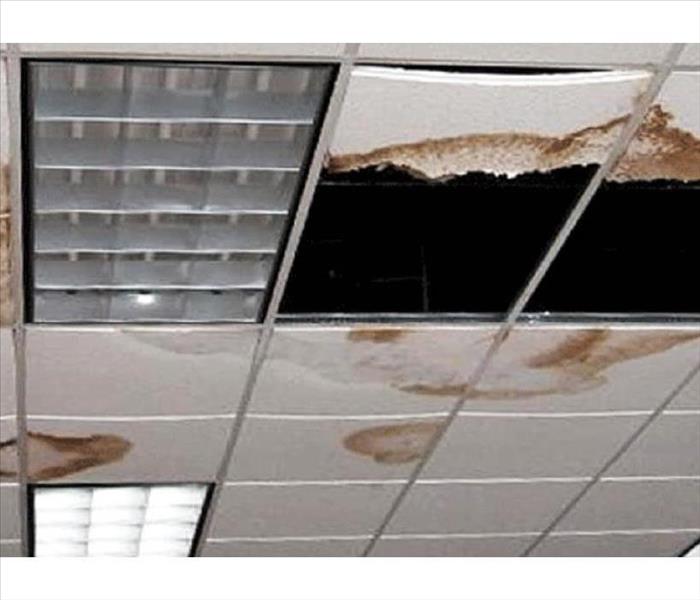 Leaks come in all shapes and sizes. With a little bit of education you can be better prepared for when they do happen.
Leaks come in all shapes and sizes. With a little bit of education you can be better prepared for when they do happen.
It only takes a small leak in a commercial building to cause extensive water damage. The longer the leak goes unnoticed, the more damage you can expect.
Common leaks detected in commercial buildings
Any building can spring a leak. But commercial buildings are put under quite a bit more stress than residential buildings, with heavy use of bathrooms, kitchens and other water-intensive processes. Learn about the most common types of leaks found in commercial buildings, and what you can do to fix them.
Faucet leaks
Every faucet has components that can wear out over time, especially with frequent use. When a seal or other faucet component begins to leak, it leads to ongoing water loss. When the drip becomes a trickle or a flow, water loss can be extensive and your water bill can substantially increase.
Toilet leaks
Toilets have a number of parts that can wear and lead to issues, especially water loss. For example, a flapper that fails to create a solid seal will allow water to leak from the toilet tank drain. If leaks like these aren’t repaired as soon as possible, you may experience additional damage to other toilet components, your water bill may increase significantly, and you may eventually have to replace the entire toilet to remedy the problem.
Underground leaks
Underground leaks often go unnoticed. Signs that you may be experiencing an underground leak include:
- Areas of wet soil
- Areas where grass, plants, or other items are growing faster than their surroundings
- Unexpected rises in water bills
Items like sewer drains, water supply pipes, or other buried piping systems require water leak detection equipment to help locate any leaks. If found, pipes can be dug up and repaired. If not, exploratory digging may be necessary to find the source of the leakage.
Hidden leaks
A leak can hide anywhere in a commercial building. If the leak is not discovered early, the amount of water loss and damage caused may be extensive.
Signs of hidden leaks include:
- Increases in the water bill
- Wet surfaces
- Water marks and swelling of the walls, ceiling, and floors
Once the leak is identified, it may require pulling out walls, ceilings, and other major pieces of the building to fix the leak and repair the damage.
How to detect plumbing leaks in your commercial building
Installing a leak detection system can make it much easier to identify potential leaks and address them as quickly as possible. These systems can be extremely beneficial in commercial buildings, as they allow for the creation of a building-wide detection system.
Technology offers some exciting innovations in leak detection. Wireless water leak detectors can communicate by phone, text, and email when a leak is detected. Cloud-based sensors are also available that integrate with a portal where you can monitor all sensors in a system. There are even automated sensors which can shut off water in certain applications. If you are unsure which type of water leak detection equipment is best for your building, consult a contractor before installation.
What to do if you find a leak
If you suspect a leak in your business, contact SERVPRO of The Saint Croix Valley. We are here to help, 24 hours a day, seven days a week. 715-381-2266.
How Long Does it Take to Repair a Home After a Fire?
1/18/2019 (Permalink)
Dealing with a home fire can be overwhelming. It takes time, money, and oftentimes unexpected factors arise that are almost always out of your control. While each restoration job is unique, it’s important to understand the general process and how long each phase can take.
The Fire Damage Repair Process
PHASE 1: MITIGATION AND DEMOLITION – 3 WEEKS
First, the mitigation vendor will come out to assess the level of damage in the home. The affected rooms will be tested for soot and smoke damage by using special sponges or gloves, and a high-efficiency particulate air (HEPA) vacuum and deodorizer will be used to clean the air. The mitigation vendor will also explain what the demolition and rebuild phase may consist of (if applicable) and determine whether it makes sense to do more complex tasks such as flood cutting, a process that determines the water accumulation in drywall, or tearing down walls and ceilings, and removing floors. These tasks may be necessary when a severe fire occurs as water damage can occur from extinguishing the fire. Lead and asbestos testing may also take place depending on the state the house is in and the year it was built.
PHASE 2: GENERAL CONTRACTOR AND SUBCONTRACTOR
The general contractor often takes on subcontractors to rebuild other parts of the home, such as installing flooring or drywall (or uses an architect for larger losses), so you can get the type of flooring, roofing, etc., you want in your newly restored home.
When all work is complete, you and your contractor will perform a final walk through to review the repairs and you will be asked to sign a Certificate of Satisfaction, which is documentation needed to close out the job.
The Amount of Time Depends on the Amount of Damage
Remember, there’s no one-size-fits-all time estimate for the restoration process. It depends on the size of the house, severity of damage and vendors involved. A small house with light damage could be fixed in a couple of days, whereas a larger job requiring a full gut (or complete rebuild) could take six months or more. It’s always helpful to ask for a scope of the work involved as well as an estimate, so you have a better sense of what to expect for your specific situation.
Here are some other things to consider when a home fire occurs:
- Permits can prevent demolition from happening. For example, you may have to hold off on a rebuild if the building fails lead or asbestos testing.
- Hire a trustworthy mitigation vendor, like SERVPRO of The Saint Croix Valley, with proper credentials and good reviews. If the mitigation is not done well, it can create more work for the general contractor.
- Avoid cleaning prior to speaking with a professional company, as it could cause further damage.
- Collect all sentimental items to handle/clean yourself to avoid potential accidents while professionals are there.
SERVPRO Can Help
If you have experienced fire damage to your home, it’s important to begin the restoration process as soon as possible. SERVPRO of The Saint Croix Valley is a qualified fire restoration company from its nationwide network to help restore your home from beginning to end. WE are just a phone call away, 24 hours a day, 7 days a week, 715-381-2266.






 24/7 Emergency Service
24/7 Emergency Service




















